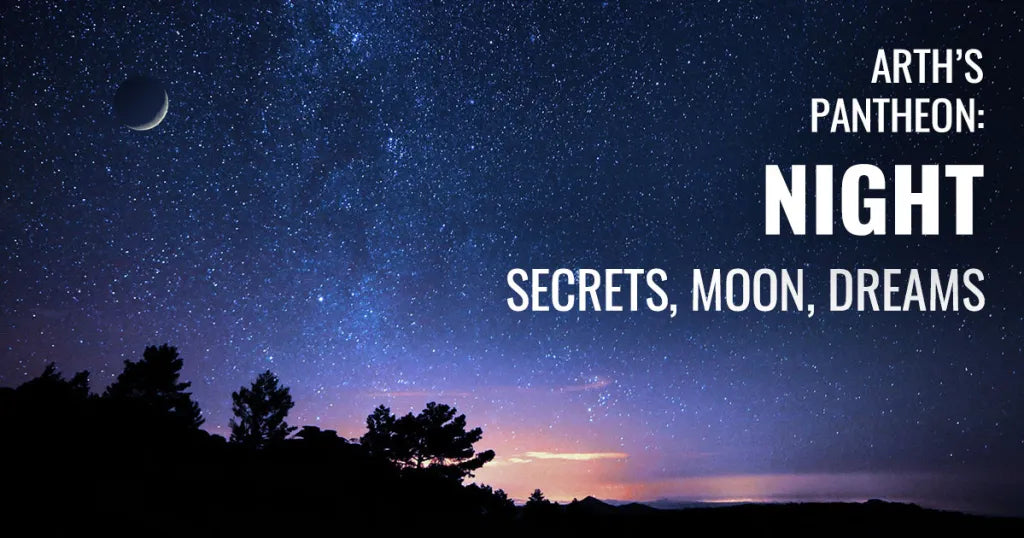
Arth’s Pantheon: The Gods of Night
Share
This is part of a series on Arth’s Pantheon. Twice a month we’re taking a look at life on Arth and the gods that shape it. If you’re new to the series, get started with an overview. This post looks at the gods of the realm of darkness.
Let’s just say it: gods of night sound evil. People associate night with fear, crime, and wickedness. But on Arth, the gods of night are seen more as mysterious and enigmatic than malevolent. The evening brings dreams, and the stars, and other wonders for those willing to seek out what is hidden by the darkness. The gods that represent them, by and large, are forces for good.
Except for that really, really evil one.
Noros
Noros was the god of dreams, associated with fancy and whim as well as hidden knowledge. Now, he is blamed for night terrors and nameless fear. In the second age, Mannon promised the King of Dreams freedom to pursue his wildest, darkest creative impulses, and Noros quickly accepted. Legends say that it was Noros who created the monsters of the War of Betrayal – the Ogres, the doppelgangers, the lizardmen, and other monstrous peoples. According to some temples, it was a spell Noros devised that transformed the Shadowkin from their former selves into Orcs, Goblins, etc., but that conflicts with the Agekeepers histories. Noros created new and hideous monsters for Nephan’s armies in the Fourth Age as well. The most feared and bizarre creatures on Arth are usually blamed on the Nightmare king.
Noros was the patron of Clan Remlon, who became the Gremlins. Very few Gremlins actually worship him, and he’s never depicted as a Gremlin in stories or artwork. Usually, he is represented as a large eyeball; it’s said that the actual visage of the Nightmare king would drive mortals insane.
Nobody knows if there are temples or shrines dedicated to Noros, but if they were discovered, the other gods would quickly move to destroy them. Since Mannon was struck down by Tandos in the Fourth Age, Noros has been the dominant force of evil and malice on Arth. He allies himself with Sitha, Mugluck, and Razar when convenient, but even Kud’gar and Az’ilgar avoid working with the Nightmare king.
- Titles: The Nightmare King, the Waiting Darkness, (formerly the King of Dreams)
- Race: Gremlin (formerly Gnome)
- Status: Formerly Dominant
- Favored Weapon: Sai
- Holy Symbol: An unblinking eyeball
- Colors: Black and Purple
Alluna
Alluna, or Allunathaliel, is the goddess of the moon, and the ruler of dreams since Noros fell into darkness. Her lights shine on secrets that nobody else sees, and she’s prayed to by those seeking hidden knowledge or power. She is often associated with magic and ritual.
Alluna is the patroness of the Order of the Moon, which is odd; Elves cannot touch noctomancy. Legends say that she was spurned by the Elves in the first age, and denied the Elves her power as punishment. Many Agekeepers dispute this, especially Gnomish Agekeepers, who note that there is no corresponding story of Gnomes angering Musana, the Sun Goddess.
Whatever the truth of her magic, Alluna has a strong following; she’s as revered in Elven lore as Musana, and popular with noctomancers among Humans and Gnomes. Even people who distrust the Order of the Moon revere the Great Lantern. She allies herself with Musana and Tandos often, and is a frequent companion to Fengelde. Nobody fights against Noros with more fervor than the Moonsinger.
- Titles: The Moonsinger, The Great Lantern
- Race: Elf
- Status: Ascendant
- Favored Weapon: Bow
- Holy Symbol: Crescent Moon, Owl
- Colors: Purple and Silver
Molner
Molner is the god of writing and runes, of hidden lore and long kept secrets. The Runebinder is also associated with the stars and aurora borealis. He is credited with teaching all the races of Man how to write, and gifting them with language. He reserved his most powerful teachings, the way of Runes, to the Dwarves, but they have forgotten most of the runic knowledge they once held.
Molner and his temples keep the traditions of scribing, runecarving, and storytelling. Many bard revere Molner after Wust, because of his connection to stories and folk knowledge. Many Agekeepers worship Molner as well. He would rather record conflicts than participate in them, but when threatened he is a formidable foe; it’s said that Molner gave the spells that sealed Deep Thoggus to mortals, and that he even bound Mannon with runes just before Tandos struck the Dark Lord down.
The tenth month of Arth’s calendar, commonly called Frostfall, is named for Molner.
- Titles: The Starscribe, the Runebinder
- Race: Dwarf
- Favored Weapon: Staff
- Holy Symbol: The Rune of Binding (Sideways hourglass)
- Colors: Midnight blue and Silver
Stennish God of Goddess
No records of the Stennish god or goddess of night exist.
- Race: Sten
- Status: Banished
That’s it for this section of Arth’s Pantheon. You can get a good overview of the gods of Arth here. There’s more Arth Lore available on the blog as well. And in case you haven’t journeyed to Arth yourself yet, check out my books for some fantasy adventure that’s so funny, it’s epic.